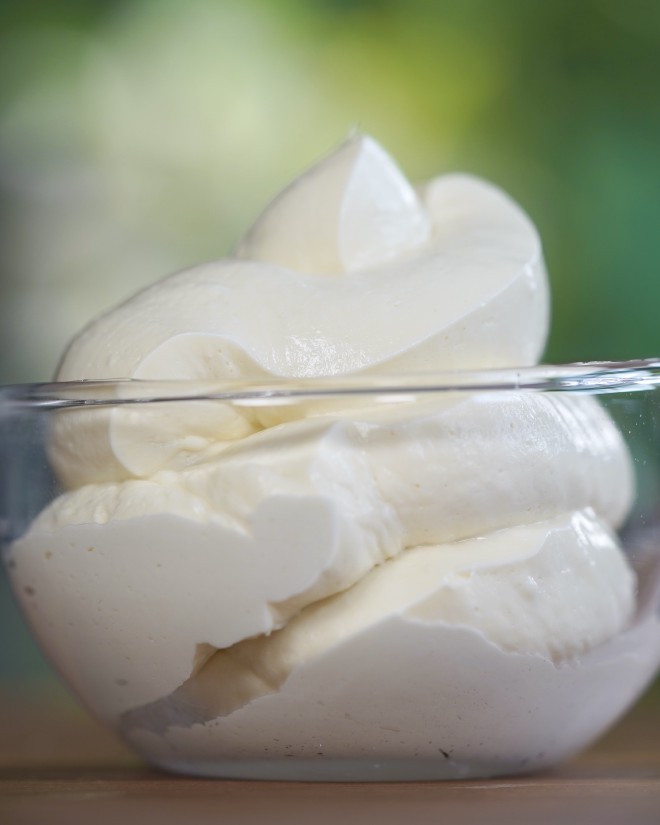Part of the Body Butters series.
Recipe
Heated Phase
- 120g Shea Butter
- 80g Fractionated Coconut Oil
Cool Down
- 2g Vitamin E Oil
- 2g Essential Oils (optional fragrance)
Method
- Measure out your heated phase ingredients: Shea butter and Fractionated coconut oil and combine in a heat proof container.
- Using either a bain-marie or double boiler, gently melt your ingredients over a low heat until completely liquid.
- Once molten, take off the heat and allow to cool until it reaches room temperature before transferring to a fridge.
- Refrigerate until the butter has set. It should have a firm smooth texture, but soft enough to penetrate with a whisk. This can take up to 2 hours.
- When the butter is firm, use an electric whisk to whip the butter until it is visibly lighter in colour and the consistency resembles whipped cream. The whipped butter should form soft peaks and easily mixed with a spoon.
- Once you’ve reached your desired consistency, add your cool down ingredients: Vitamin E Oil and any optional Fragrance or Essential Oils
- Whip your butter again to ensure the cool down ingredients are thoroughly mixed.
- Store your whipped butter in a dark tinted jar away from sunlight. The whipped butter will continue to firm up over the next 24 hours.
This recipe makes 200g of Whipped Butter, and will last for approximately 12 months. See the interactive formula to customise this recipe.

What are Whipped Butters?

Whipped butters are vegetable butters that have been mixed with an oil to make them lighter and easier to use. Not quite a body butter, they create a “spreadable butter” that work well as simple natural moisturisers. The butter and oil are gently heated, then re-solidified - and finally whipped to incorporate air. Once the butter is in an aerated state, the “whipped butter” is much easier to massage into the skin and is significantly softer than the standalone butter.
If your goal is to get the full benefit of a butter, then whipped butters are the way to go!
How to whip any butter
Shea butter is a popular choice amongst butter enthusiasts so it serves as a base for this whipped butter formula, however, the method above will work for all varieties of vegetable butters. To ensure you get the fluffiest butter everytime, I’ve created some guideline below for you to follow.
- Use a butter that is solid at room temperature. While it is possible to whip low melting point butters such a mafura butter, for a simple whipped butter recipe it’s best to use solid butters that will provide stability.
- Use between 20% - 40% oil. I’ve found that most commonly available butters will work within this range of oil. For higher melting point butters like cocoa butter and kokum butter, I recommend using at least 40% oil, but softer butters such as mango butter, you can go as low as 20% oil.


- Only whip when the butter is completely set. The point at which you incorporate air into the butter is crucial for determining the final texture. It’s important to make sure the butter is set through, but soft enough for the whisk to penetrate. As whipped butters don’t have additional thickeners, I don’t advise whipping at a semi-set or “trace” consistency as it tends the final whipped butter tends to deflate over time.
- Don’t use solid oils. I’d recommed sticking to solid butters and liquid oils.
The difference between whipped butters and body butters
Whipped butters traditionally only contain two types of ingredients: butter and oil. The key is in their simplicity, as an easy way to create spreadable butters that can be used as a standalone moisturiser. Whipped butters are all about the butter, shea, cocoa, mango, tacuma, they can come in as many varieties as there are butters. The oil only serves to loosen the natural texture of the body but make no mistake - the star of the show is the butter.
Body butters are more of a complete product. Whilst they are still anhydrous (water-free) products, they typically contain other ingredients to help with the final texture of the moisturiser.


It’s common to find additional thickeners such as fatty alcohols or acids, waxes or emulsifiers, with texturisers such as starches and powders.
Their goal is to limit the “oiliness” of natural butters and oils, whilst still providing a decadent and intense moisturiser. Body butters can also be “whipped” or left as a balm.
There are slight differences in texture between whipped butters and body butters. Whipped butters tend to have more body and feel a little heavier on the skin as they are primarily just butter.
